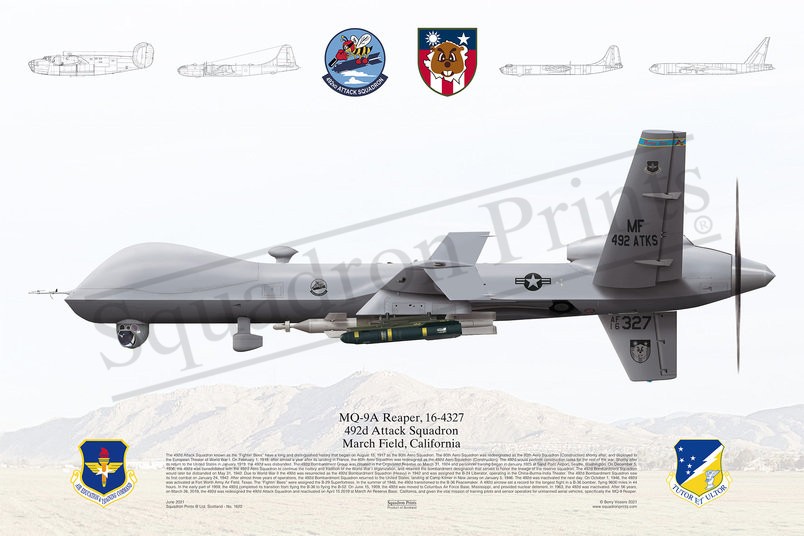#1622 MQ-9A Reaper print

Description
Squadron Prints Lithograph No. 1622 - 16-4327, MQ-9A Reaper, 492d Attack Squadron, March Field, California.
The 492d Attack Squadron known as the “Fightin’ Bees” have a long and distinguished history that began on August 15, 1917 as the 80th Aero Squadron. The 80th Aero Squadron was redesignated as the 80th Aero Squadron (Construction) shortly after, and deployed to the European Theater of World War I. On February 1, 1918, after almost a year after its landing in France, the 80th Aero Squadron was redesigned as the 492d Aero Squadron (Construction). The 492d would perform construction tasks for the rest of the war. Shortly after its return to the United States in January 1919, the 492d was disbanded. The 492d Bombardment Group was created in the Organized Reserve on March 31, 1924 and personnel training began in January 1925 at Sand Point Airport, Seattle, Washington. On December 5, 1936, the 492d was consolidated with the 492d Aero Squadron to continue the history and tradition of the World War I organization, and retained the bombardment designation that served to honor the lineage of the reserve squadron. The 492d Bombardment Squadron would later be disbanded on May 31, 1942. Due to World War II the 492d was resurrected as the 492d Bombardment Squadron (Heavy) in 1942 and was assigned the B-24 Liberator, operating in the China-Burma-India Theater. The 492d Bombardment Squadron saw its first combat on January 24, 1942. After almost three years of operations, the 492d Bombardment Squadron returned to the United States, landing at Camp Kilmer in New Jersey on January 5, 1946. The 492d was inactivated the next day. On October 1, 1946, the 492d was activated at Fort Worth Army Air Field, Texas. The “Fightin’ Bees” were assigned the B-29 Superfortress. In the summer of 1948, the 492d transitioned to the B-36 Peacemaker. A 492d aircrew set a record for the longest flight in a B-36 bomber, flying 9600 miles in 44 hours. In the early part of 1959, the 492d completed its transition from flying the B-36 to flying the B-52. On June 15, 1959, the 492d was moved to Columbus Air Force Base, Mississippi, and provided nuclear deterrent. In 1963, the 492d was inactivated. After 56 years, on March 26, 2019, the 492d was redesigned the 492d Attack Squadron and reactivated on April 15 2019 at March Air Reserve Base, California, and given the vital mission of training pilots and sensor operators for unmanned aerial vehicles, specifically the MQ-9 Reaper.
You may also like
-
306 Sqn, F-16A(R) Fighting Falcon Squadron Print
J-647306 SqnVolkel Air Base, The Netherlands
